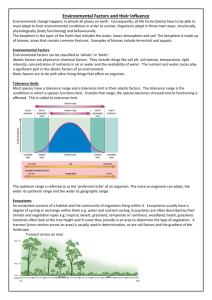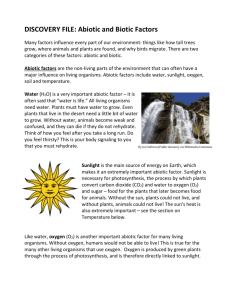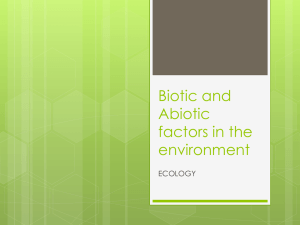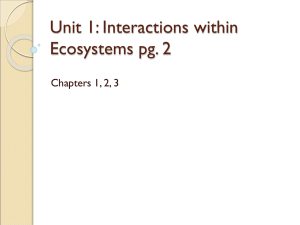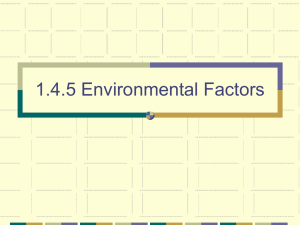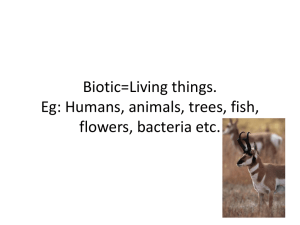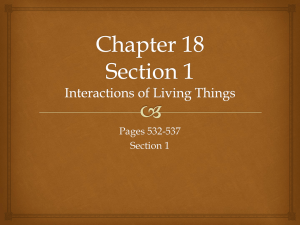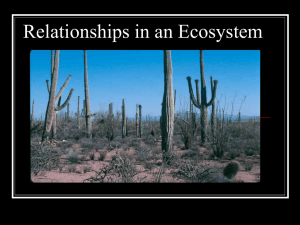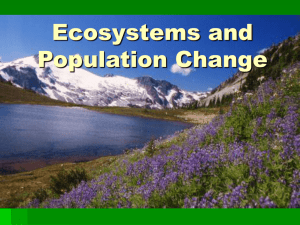Living things depend on the environment
advertisement
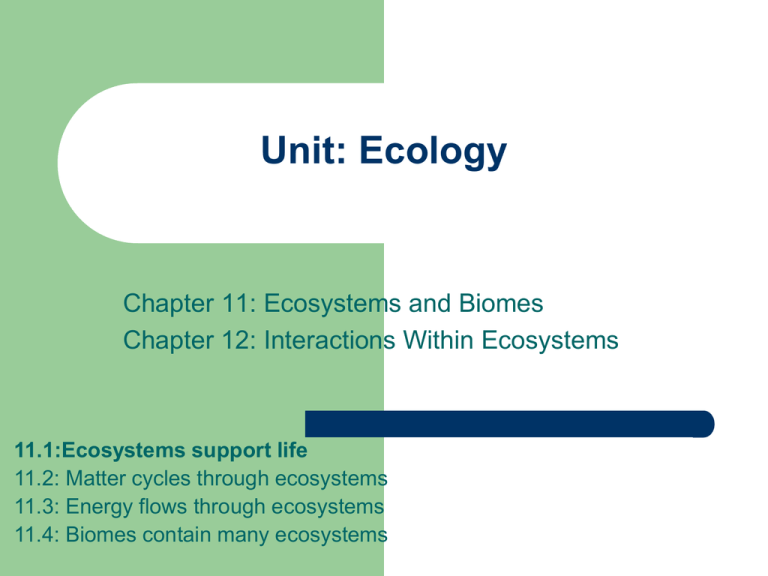
Unit: Ecology Chapter 11: Ecosystems and Biomes Chapter 12: Interactions Within Ecosystems 11.1:Ecosystems support life 11.2: Matter cycles through ecosystems 11.3: Energy flows through ecosystems 11.4: Biomes contain many ecosystems Concept Overview Temperature can vary from place to place 1. It surrounds all living things 2. All living organisms need it 3. It gives Earth most of its energy – – – – – A. organism B. energy C. the ocean D. environment E. the sun 1. d, 2. b, 3. e Living things depend on the environment Ecology: the scientific study of how organisms interact with their environment and all the other organisms that live in that environment Ecosystem: describes a particular environment and all the living things that are supported by it – – Ex: pond, desert Important: how the living parts of the ecosystem relate to the nonliving parts Living things depend on the environment Pond: – Biotic factors: living parts – water, fish, plants in and around, animals feed on the plants, fish feed on microorganisms in the water Abiotic factors: nonliving parts Air (carbon dioxide and oxygen), soil (nutrients), water, sunlight Biotic factors interact with an ecosystem Living things depend upon an ecosystem, and also have an impact on the ecosystem in which they live Plants (biotic) affect biotic and abiotic parts of ecosystems – Biotic: – Abiotic: affect temperature by blocking sunlight Roots hold soil in place Photosynthesis - Carbon dioxide and oxygen Animals (biotic) affect ecosystems – – – An important source of food – help determine types of animals that can live there Ex: beaver builds a dam which changes the flow of a river and affects the surrounding landscape Ex: herds of cattle can overgraze a grassland – causing soil erosion, and climate impacts Ex: corals form giant reefs that provide food and shelter for marine organisms Other examples? Many abiotic factors affect ecosystems Physical parts: – Chemical parts: – – You can see or feel: temperature, rainfall, water level, sunlight, etc. Minerals and compounds in the soil and water Fresh/salty water Abiotic factors determine what organisms the ecosystem will support Abiotic Factor: Temperature Affects types of plants that will do will in an ecosystem, which determines the types of animals that can live there – – Ex: Rainforest: temperatures affect the plants that can grow and support a variety of monkeys, birds, and others Ex: musk oxen have at hick coat of fur for survival in very cold environments (-40F), water buffalo has a light coat better for warmer temperatures Abiotic: Light Sunlight and temperature are related Sunlight is also used for energy: photosynthesis – The food from plants supports almost all other living things on Earth Strength and amount of sunlight are important – Desert: cacti can survive where sunlight is strong – Forest: mosses and ferns do well with less light Ocean Ecosystems: deeper water, less light – Photosynthesis only performed to the first hundred meters below the surface Euphotic (or photic) zone - the depth of the water in a lake or ocean, that is exposed to sufficient sunlight for photosynthesis to occur. Abiotic: Soil Soil: mixture of small rock and minerals Organisms in the soil can break down the remains of dead plants and animals – Soil types vary and affect plant growth – – – This decay provides important raw materials to living plants and animals Lots of decaying, or organic, matter: holds water well and allows air to reach plant roots Sandy soil holds water poorly Clay soil: small packed particles, does not aerate well Minerals Abiotic: Water “All living things need water to carry out life processes” Plants need water for photosynthesis Animals need water to digest food and release energy stored in the food Desert Oasis: forms when underground water comes to the surface Ecosystesm with lots of water can support a large number of different types of plants, which in turn support a variety of types of animals – Rainforest vs desert * “the types and number of living things in a land ecosystem will always be related to the amount of fresh water available for its inhabitants” http://www.glencoe.com/sites/common_asset s/science/virtual_labs/CT08/CT08.html
